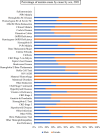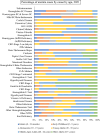Burden and causes of anemia in Vietnam: insights from the global burden of disease data
- PMID: 39482626
- PMCID: PMC11529559
- DOI: 10.1186/s12889-024-20497-7
Burden and causes of anemia in Vietnam: insights from the global burden of disease data
Abstract
Background: Anemia is a significant global health issue, impacting 1.92 billion people and ranking as a leading cause of disability. It is marked by low hemoglobin levels, which hinder oxygen delivery to vital organs and result from causes such as nutritional deficiencies and chronic diseases. Despite some progress, anemia remains a major concern in Southeast Asia, including Vietnam. Although the country has reduced its anemia rates, the progress is insufficient to achieve the WHO's 2030 targets for anemia reduction among women of reproductive age. This study explores anemia trends and socio-economic determinants in Vietnam, with a focus on age and gender differences, to inform targeted interventions and policy development.
Methods: This study used the Global Burden of Diseases, Injuries, and Risk Factors (GBD) dataset to explore the burden of anemia and its causes in Vietnam from 1990 to 2021. The GBD study provides data on anemia prevalence and years lived with disability (YLD) by age, sex, and 37 causes across 204 countries and territories. Further, this study employed a regression model to examine how the anemia burden (i.e., prevalence rate and YLD rate) relates to socio-economic factors such as the Human Development Index (HDI), gender disparities in human development achievement, and gender-based inequalities in reproductive health, empowerment, and economic status in Vietnam over this period.
Results: In 1990, there were 16.30 million anemia cases in Vietnam, decreasing slightly to 16.05 million by 2021. Male prevalence dropped from 34.90 to 26.58%, while female prevalence increased from 65.10 to 73.42%. Iron deficiency was the main cause, affecting 68.35% of cases in 1990 and 68.84% in 2021, with 24.96% in males and 75.04% in females in 2021. While anemia has decreased among infants, young children, and adolescents due to improved healthcare, it has increased among middle-aged and older adults, especially females. Regression analysis shows that higher human development and gender equality reduce anemia prevalence and disability, whereas gender inequality worsens the issue.
Conclusions: The study underscores that anemia remains a major health concern in Vietnam, marked by significant gender and age disparities. Despite a decrease in overall anemia rates and the effectiveness of specific interventions like iron-folic acid supplementation, females, particularly those of reproductive age and older adults, continue to face higher rates. Socio-economic improvements, including higher income and better human development, are linked to lower anemia rates, though the impact differs by gender. The persistent gender disparity and the shift in burden to older adults highlight the need for more comprehensive, gender-sensitive interventions. Future efforts should integrate nutritional support with broader socio-economic enhancements to effectively address anemia and improve public health in Vietnam.
Keywords: Anemia; Global burden of disease; Prevalence; Vietnam; Years lived with disability.
© 2024. The Author(s).
Conflict of interest statement
The authors declare no competing interests.
Figures






References
-
- Global Burden of Disease Study 2021. (GBD 2021) Anemia prevalence and years lived with disability by cause 1990–2021 | GHDx. IHME. 2021. https://ghdx.healthdata.org/record/ihme-data/gbd-2021-anemia-prevalence-... (accessed May 23, 2024).
MeSH terms
LinkOut - more resources
Full Text Sources
Medical

